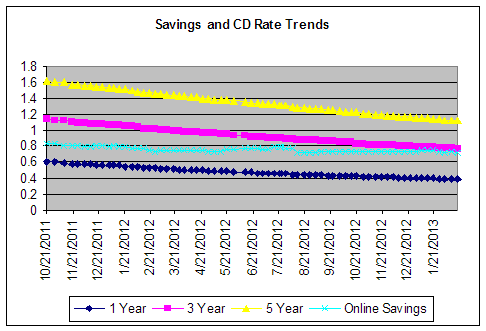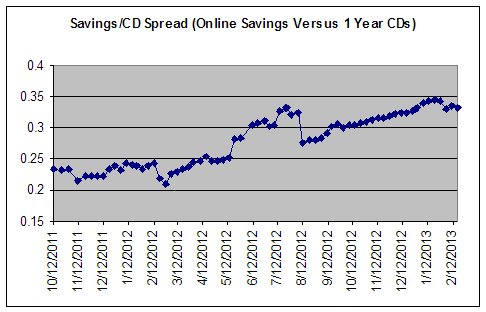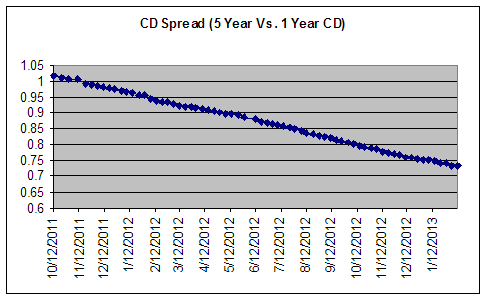The big news this week is the downfall of the former heavyweight in the online savings arena. Salem Five Direct, which had the top online savings account paying 1.25% APY lowered their rate to 1.00% APY. That leaves AmTrust Direct with the top nationally available online savings rate at 1.05% APY.
Average rates continue their five year treck of heading down. Average one-year CD Rates dipped from .392% to .389% APY. Three year average CD rates dropped from .774% to .769% APY. Five year average CDs dropped to from 1.125% to 1.119% APY. Online savings accounts dropped from .728% to .720% APY.
Top rates Some top rates are:
Local banks and credit unions often offer better rates (especially for CDs) than online banks so be sure to check them out. View local CD rates in your area.
The chart below shows the trend in average rates since October 2012.

The difference in the rate of decline between online savings and CD rates can be viewed on the chart below, which shows the spread between online savings account rates and 12 month CDs. The spread still remains very elevated although it has come down a bit in recent weeks as online savings rates have declined a bit. On average, online savings account rates pay .331 percentage points more than 1 year CDs, up from .23 percentage points more at the beginning of last year.

General rate environment
The government and private sector released very little economic data this past week. One point is that the S&P 500 rose to its highest level in 5 years this week. Low interest rates have propelled the stock market for the past five years and the music has not stopped playing. I don't see the rising stock market as an indicator of higher interest rates ahead, but rather as a product of the Fed's low interest rate policy. For now I am leaving my forecast unchanged although many economists are lining up and predicting 2016 will be when the Fed starts raising rates (read this article in Bloomberg).
My outlook: Savings rates will continue to drift lower for the next 10-16 months before beginning to move higher. How high and how fast they move will depend on the government's ability to stop bickering and resolve their budget and borrowing disputes, the continuation of a recent economic uptick, technological advances, and the ability of Europe to put its woes behind it and resolve its fiscal problems.
My reasoning includes:
- The Fed has committed to keeping rates exceptionally low as long as unemployment is above 6 1/2 percent. It currently stands at 7.9%. At the current rate of decline, it will take at least 2-3 years to get to 7.9%. If the economy picks up, it could get there sooner.
- The economy has picked up a bit of steam in the last couple of quarters. But GDP growth of 1-2% will not be enough to quickly bring down the unemployment rate. I project steady but moderate economic growth of around 2.5% in 2013.
- Bank are awash in cash from individuals and corporations and do not need more deposit dollars. Third quarter 2012 FDIC data showed banks had over $9 trillion in deposits, up from $8.5 trillion in the third quarter of 2011. Many banks are having trouble figuring out how to deploy their cash. Part of this is because of lending fears and credit quality and the other part is due to increased governmental oversight.
- Demographic trends are unfavorable. Unfortunately, the United States has entered a demographic slide. As the large baby boom generation ages and retires, this puts a large strain on the country's productivity and spending. I believe that demographics is a general driver of economic development. A young population lifts all boats. An aging will leave quite a few boats stranded and make it difficult for the others. Japan and Europe have even worse demographic problems and their economies reflect that. As China's population ages, look for its growth to ebb. This demographic slide will be a factor for the next ten to twenty years, not stopping growth, but certainly acting as a headwind.
- Government grid-lock. The debt ceiling threat has been raised for now but sequestration still looms. It's clear that these battles will continue to occur anytime a budget decision is needed until one philosophy prevails. At this point, a bi-partisan solution looks unlikely. The partisan bickering does little to establish confidence.
- Local, state, and government cuts and tax increases are going to slow the economy. Even if sequestration is avoided, government at all levels is cutting back and raising taxes. At this point, it looks doubtful that businesses and the consumer will be able to make up the difference (especially with rising taxes).
Savings Accounts or CDs?
The data continues to show that opening a savings account is a better bet than a 1-3 year term CD and I expect this to hold through 2013. Online savings accounts have held the line over the past year while CD rates continue to fall.
So for now, here are my recommendations:
For money you want to keep liquid, go with online savings accounts. They offer better rates than 1-3 year CDs and have shown good rate stability over the past year.
For longer-term money, look to open 4-5 year CDs at local community banks. BestCashCow research has shown that community banks and credit unions offer the most competitive rates on longer-maturity CDs.
I believe this is the best and easiest strategy for keeping your cash liquid and maximizing your savings over the next year.

Make the best of a tough savings situation in 2013
Yields may be low in 2013 but a savvy saver can boost the return with no increase in rate by rate shopping. By shopping around, a saver can earn an extra half to full percentage point. On $100,000, that's $1,000 in extra cash per year. Remember, even in today's environment, there is competition for your cash.



